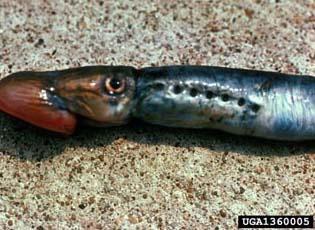Petromyzon marinus (Linnaeus, 1758) (ITIS)
Sea Lamprey
Atlantic Ocean (NAS Database)
First discovered in Lake Ontario in 1835 (though whether or not it is native to Lake Ontario is disputed); first discovered in Lake Erie in 1921 (NAS Database)
Spread into the Great Lakes through the Welland Canal (NAS Database)
Preys on native species (NAS Database)
Great Lakes

Sea lamprey, adult
Photo by Lee Emery; U.S. Fish and Wildlife Service
Find more images
Spotlights
Distribution / Maps / Survey Status
Videos
All Resources
Selected Resources
The section below contains highly relevant resources for this species, organized by source.
Partnership
Federal Government
State and Local Government
Academic
Integrated Taxonomic Information System. Petromyzon marinus. [Accessed Sep 22, 2023].
Nonindigenous Aquatic Species Database. Fact Sheet - Sea Lamprey. USGS, Gainesville, FL. [Accessed Sep 22, 2023].
 An official website of the United States government.
An official website of the United States government.